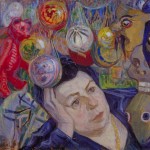Moshe refused his son’s help to get him out of the Warsaw Ghetto. That decision meant he eventually was deported and that he perished in the Holocaust. The family believes he was murdered at Majdanek. Moshe’s wife, Perla, followed her son’s advice and got out of the ghetto. She survived the war. The two paragraphs below are from the memoir written by Moshe’s son, Jerzy (later Americanized to George). The two photographs are of Perla after the Second World War. The painting is a portrait Moshe made of Perla in in 1929.
The only package found by mother and a cousin, Sophie Binstock, was in Praga, across the river Vistula. They were looking for all the hidden parcels. The only one found was in a cellar in Praga. The people were away, and the paintings, all on paper or parchment, fairly small, were strewn on the basement floor in the cellar. Some damaged, some cut in half with scenes missing. They seemed to have gone through the same fate as the Jewish people—massacred and destroyed.
About 12–15 percent of Jews survived the Holocaust. So did my father’s paintings. One hundred and twenty were found out of a count of close to eight hundred works. He was very prolific. Always working, it seemed, day and night for all his life. Never erring, he was always assured of his own knowledge and artful direction. One in millions of his brothers, I understand he was painting and sketching constantly in the ghetto for four years. What a loss to the Jewish people, their history, and culture. The last four years of his life he spent in the Warsaw ghetto, against my advice and wish to save him. He was sent to Majdanek in July 1943, with this sentence said to me a few days before his transport, “I’ll go where my brothers and sisters go, and if it means death, so be it.” He was killed, of course, with the others, DIED = “BEKIDUSH HASHEM.” In sanctification of THE NAME. All his works in the ghetto were never found, most probably destroyed. – From Surviving Hitler in Poland: One Jew’s Story by George J. Rynecki
Photos of Perla from after the war. The painting is a portrait done by Moshe Rynecki in 1929


